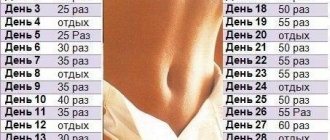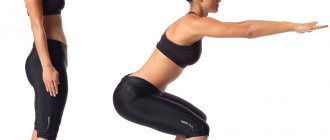Basic program for mass
This complete muscle building workout program includes two essential growth factors.
- Special sets of exercises aimed at muscle growth;
- Rich nutrition to build muscle.
Together, these tactics target the body from both sides. Muscle-building workouts will force your body to change, while “rich nutrition” will provide it with “building blocks” and energy.
Essentially, you will be tearing down the wall and building a bigger one each time. Although muscle tissue is not real bricks.
There are no time limits for this plan. It's up to you how long to stick with it. You can do this program as long as you continue to progress in strength gains (that is, work weights increase) or muscle growth.
It will be hard. But let's be honest - is it possible to achieve anything worthwhile while sitting on the couch at home? One thing is for sure, it will be fun! You'll lift weights left, right and center while eating in a calorie surplus. Ask any athlete and they will tell you that nothing beats gaining muscle size.
Training process
One way to gain weight is to accelerate the changes through strength training. For the average person, they are well known as lifting as heavy a weight as possible.
Sounds scary, right? Because that's how it is.
Every time you lift a weight, tiny micro-tears of muscle tissue occur. If recovered well with sufficient rest and proper nutrition, this tissue becomes thicker, making the transverse surface area of the muscle larger. This is how people become embossed.
Workouts for muscle growth
As part of this program, you will work to continually increase your volume. So, instead of strength or endurance, your goal will be intense hypertrophy. After all, that's what you're here for, right? Exactly.
Everything you need to know about muscle hypertrophy is in our article.
For further muscle growth, you need to focus your training on hypertrophy, which occurs with the right amount of strength training. In other words, you will lift heavier weights for more repetitions. For what? Because volume is the key to muscle growth... and volume equals weight lifted for "x" reps - it's as simple as that.
This program builds volume over a three-day, full-body workout plan. Research has proven that this style is superior to traditional strength splits. That's why we use a 3-day training program to gain muscle mass.
You will also use the method as a progressive load. This means adding weight to the bar at every opportunity without compromising safety. Once your muscles adapt to the weight being lifted, you will lift it even more to increase your overall volume.
Basic exercises versus isolation exercises
Because you're choosing a full-body approach rather than conventional split training, you'll be performing a reasonable number of multi-joint movements known as compound exercises.
While isolated movements target specific areas, multi-joint movements involve multiple muscle groups at once, resulting in an increase in the number of muscle fibers.
Additionally, there is another factor; you can lift heavier weights during compound exercises. Although you might be able to increase the number of sets on just your arms, you should also be able to perform many more movements using your leg and shoulder muscles.
As a result, higher training volume can take a long time. You already know how important overall volume is, right?
The best way to find the best exercises for gaining mass is mixed. Start with more energy-intensive compound exercises before moving on to isolation exercises. Imagine a sculptor shaping the shape of a sculpture first with the largest tools, and then giving it grace with small chisels and hammers.
Characteristics
No matter how specific the system of functional training may be in relation to certain sports, its very essence comes down to practicing the movements necessary for a person in everyday life or in extreme conditions. This could be lifting weights at home or at work, stepping over obstacles, holding a child, climbing a stepladder, jumping off a high platform and so on, the list can be endless. The main thing here is that thanks to functional training, the muscle corset is strengthened and stabilizer muscles are developed.
A characteristic feature of functional training is the use of free weights, expanders, bollards, jump ropes, balls, platforms and other equipment, which allows you to perform movements not along a fixed trajectory at a given amplitude, as in weight-block simulators, but in free movement, since most of the exercises are performed with your own body weight. This allows your muscles to reproduce movements as naturally as possible, as they usually do in everyday life. The high effectiveness of functional training lies in the fact that it involves almost all the muscles of your body, including the deep ones, those responsible for stabilization, balance and smooth movements. As mentioned above, this type of training makes it possible to improve the five main parameters of your body - strength, flexibility, speed, coordination and endurance.
3-day full body program
This training program is designed for a minimum of four weeks of training. Making your body strong and sculpted is not easy, but in a month you will get a result that you will be proud of. Combined with proper nutrition, this plan will make you leaner, stronger and fitter.
Additionally, to avoid overtraining, we suggest resting for a few days after 12 weeks of training. Don't worry about losing muscle, your body will be grateful for the break.
If you are a complete beginner, then first you need a training program for beginners to prepare your muscles and ligaments for power loads.
When doing this bulking plan 3 times a week, try to leave at least 24 hours between each workout. This is important for muscle growth, since the body needs time to recover. By taking a day of rest between visits to the gym, you give your body the opportunity to better recuperate.
This is the program...
- Deadlift - 4 sets of 12 reps;
- Bench press - 4 x 12;
- Standing press - 4 x 12;
- Romanian deadlift with dumbbells - 4 to 14;
- Standing dumbbell flyes – 4 to 14;
- Plank with dumbbells - 4 x 16 (8 + 8).
- Squats with a barbell on the shoulders - 4 to 12;
- Incline dumbbell press – 4 x 12;
- Wide grip pull-down to the chest - 4 to 14;
- French press - 4 x 14;
- Biceps training in the simulator - 3 to 21 (7 + 7 + 7 in partial amplitude);
- Hyperextension - 4 to 12.
- Front squats - 4 to 12;
- Deadlift on straight legs - 4 to 12;
- Alternating lunges with dumbbells - 4 to 14 (7 + 7);
- Incline dumbbell press – 4 x 12;
- Vertical thrust - 4 to 12;
- Bent-over dumbbell rows – 4 x 14 (7 + 7).
The most attentive may have noticed that we did not prescribe rest. It's not that we're lazy or have forgotten about them, it's just that science says you can regulate them yourself.
Either way, you will make your muscles grow. Mechanical stress increases with longer rest times because you are fresher and therefore can lift more. At the same time, muscle damage increases due to short rest, which is explained by certain metabolic intermediates.
So just rest as much as you need. Lower the dumbbells and pick them up again as soon as you're ready.
Functional exercises
Functional training includes a great variety of movements, exercises, their combinations and execution options. This is due to the fact that each individual sport from which the exercises were removed provides a fairly extensive arsenal of general physical training. However, a certain core of exercises is always taken as a basis, which in the basic variation of execution is suitable for all levels of training. This core is divided into four categories of exercises:
Category No. 1. Exercises with weights. These include: squats with a barbell, deadlifts, snatch and jerk of the barbell, swings with a kettlebell.
Category No. 2. Bodyweight exercises. These include: squats, lumbar extensions, jumping jacks, push-ups, lunges, burpees.
Category No. 3. Exercises with special equipment. These include: dips, pull-ups, and rope climbing.
Category No. 4. Exercises to overcome the distance. These include: steeplechase, long-distance cross-running, rowing on a special machine.
Nutrition for muscle building
When it comes to gaining muscle, nothing beats the right diet. It doesn't matter how hard you train, it doesn't mean anything if the amount of training you do isn't up to the task.
But, you are not the kind of person who will allow this to happen.
The first thing you need to know about building muscle fibers is how they are built. Remember when we told you about rebuilding a wall after you damaged it with strength training? Yes? Great, this is only possible thanks to protein.
Protein is essentially the building material for muscles. Therefore, it is vital that your diet contains enough of it to stimulate muscle growth. More on this later.
But to become ripped, protein alone is not enough. Will not work. You should also eat enough healthy fats to support your health and hormonal balance, while at the same time getting energy for your workouts from carbohydrates.
The “muscle” diet should include everything. The key is to find the right balance of key macronutrients and essential vitamins and then incorporate them into your clean, healthy diet. Let's figure out what you need to eat.
Protein is a macronutrient used by the body to build and repair muscle tissue. It is found in many foods, with meat, eggs, beans and dairy products being the main sources.
Here is a short list of the most popular protein sources used by athletes:
- Chicken breast;
- Lean beef;
- Turkey breast and stuffing;
- Eggs;
- Fish;
- Soy;
- Legumes;
- Protein supplements (whey and plant-based options).
The body uses the protein you consume to repair damaged cells. So, obviously, you need a lot of it.
If you consume less, the body will struggle to maintain and fill existing muscle fibers, not to mention its growth. We recommend sticking to the upper end of this range for muscle building. Maybe a little more if you are very thin.
A great way to ensure you can eat enough amino acids is to split your protein intake. Instead of sticking to three meals a day, choose six meals. Just make sure protein is included in each one (about 20-30g) and it will be easy.
Many meal plans discredit carbohydrates. But the reality is that they are needed as a source of energy.
By consuming the optimal types of carbohydrates at the right times, you will undoubtedly gain muscle. In addition, with enough of them, you will look bigger and feel stronger.
In dietetics, there are two main types of carbohydrates. They are known as complex and simple carbohydrates.
Complex carbohydrates are longer chains of saccharides. Their greater length and complexity of structure mean that the body requires more effort to digest. The energy from them is released slowly and maintained for a longer period of time.
On the other hand, simple carbohydrates are shorter chains that are digested faster. As a result, the body receives energy much faster. Hence the sudden surge and then decline in energy after consuming foods high in refined sugar.
Here are some popular carbohydrate sources:
- Brown rice;
- Sweet potato;
- Oatmeal;
- Quinoa;
- Whole grain pasta;
- Wholemeal bread.
- Table sugar;
- Sports drinks;
- White rice;
- White bread;
- Sparkling water;
- Cakes;
- Cookie;
- Pasta made from wheat flour;
- Candies.
You should aim to include complex carbohydrates in your breakfast to start the day, in your other main meals, and in the two hours before your workout. This gives the body enough time to digest them and convert the sugar into glycogen, which fires muscles.
In contrast, simple sugars provide the body with energy almost instantly. It doesn't take much effort to break them down into glucose, which is then stored and used in the muscles as glycogen. In order for simple sugars to be an effective source of energy for training or recovery, they should be consumed close to the start of exercise.
Unfortunately, fats have not been popular in recent history. However, we are here to talk about their fundamental importance for every person.
Research has shown that men experience a 12% reduction in natural testosterone levels after eight weeks of a low-fat diet. So if you want to stay healthy, don't believe the hype.
If you want to build muscle, testosterone is your best friend. Not only does it promote the development of important masculine traits, but it also supports muscle growth. Add strength gains to the mix and you'd be a fool to ignore fats.
But what type of fat should you eat? Good question. Here are some helpful male hormone boosters to put on your plate:
- Whole eggs;
- Salmon;
- Liver and offal;
- Nuts.
At the very least, try to avoid artificial fats. They are often found in processed foods such as cakes and cookies, or in ready-to-eat snacks.
Nutrition by Mark Fitt
Mark believes in eating a healthy diet high in protein and low in carbohydrates for better muscle development. Below you can see his current meal plan.
• Meal 1 : Banana, 60g rolled oats, 8 egg whites, protein drink (30g), 2x multivitamin, 2x omega-3, vitamin B and 5g glutamine.
• Meal 2: Apple, 10 almonds, 45 g protein, chicken breast.
• Meal 3 : 2 Chicken breasts, a cup of vegetables, 2x multivitamin and 2x omega-3 fatty acids.
• Meal 4: Pre-workout meal (2-3 hours before training) - 30 g protein drink, 60 g oatmeal and 15 g honey.
• Pre-workout drink : 1 ½ scoops stimulant (30 minutes before workout), 15 g BCAA (15 minutes before workout).
• Post-workout drink: 45 g whey isolate, 60 g dextrose, 5 g creatine monohydrate, 5 g glutamine and 5 g BCAA.
• Meal 7: 1 ½ chicken breasts, 1 cup vegetables, 2x omega-3.
• Meal 8: 4 egg whites, 30 g casein protein, 5 g glutamine and 3 ZMA tablets [2]
His favorite nutritional supplements:
Whey Whey Protein is the most important supplement for building and rebuilding your body and figure with essential nutrients after an intense workout.
BCAA - prevents muscle degradation during training, adds more energy and promotes muscle growth .
Multivitamin - perfectly supports health, energy levels and provides the body with all the necessary vitamins for regeneration and maintenance of activity. [1]
Training program for gaining weight
For anyone looking to gain large amounts of muscle mass, one of their top priorities should be figuring out the best training program. There are many different training programs available, so it is important to choose one that suits your needs.
It is also important to understand what factors contribute most to muscle growth, what exercises are most effective for gaining muscle mass, and a program based on these principles will be much more effective.
We have collected for you the best weight training programs that show amazing results with the right approach. Let's take a quick look at the most effective and popular strength training programs and identify the pros and cons of each.
The Best Training Plans for Muscle Growth
Program "5x5"
The 5x5 training program is very popular among those who want to build large amounts of muscle mass and increase strength.
The program involves performing 3 main exercises targeting the main muscle groups (both upper and lower body in one workout). These exercises are performed in 5 sets of 5 repetitions. If you want, you can add a few sets of isolation exercises at the end of each workout, but this is not included in the program.
One of the main advantages of this program is the increased frequency of training. Since you will be stimulating a large number of muscle fibers every other day, you will notice a high level of testosterone release, which is good for muscle growth.
Most people also report that they experience increased hunger while following this program, which speaks to its intense nature.
The downside to this program is that it is likely not suitable for beginners due to its intensity, which can lead to overtraining. It is best to first gain experience in strength training for 3-6 months, so you can be sure that your body is ready for such a stressful load.
The second drawback of the program is that such intensive weight lifting 3 times a week does not combine well with other active sports. If you play a high-impact sport, you may want to consider a slightly less demanding program to avoid excessive fatigue.
Example training
You should try to follow the 5x5 formula for the main exercises as described above, and then reduce the volume of the load in the additional exercises.
If you're having trouble recovering from workouts, try following the 3x5 formula first and see how it feels. It is very easy to overtrain with this program if you are not careful.
Alternate program "A" with program "B" three times a week, resting at least one day between workouts. Try to rest for 1-2 minutes between sets of the main exercises and 30-45 seconds between sets of the additional exercises.
Workout "A"
- Barbell Squats: 5 sets of 5 reps (basic)
- Bench Press: 5 sets of 5 reps (basic)
- Bent-over barbell rows: 5 sets of 5 reps (basic)
- Pull-ups: 2 sets of 8 reps (optional)
- Dumbbell Lateral Raises: 2 sets of 8 reps (optional)
- Ab Raise: 2 sets of 15 reps (optional)
Program "B"
- Front Squats: 5 sets of 5 reps (basic)
- Military Press: 5 sets of 5 reps (basic)
- Deadlift: 5 sets of 5 reps (basic)
- Push-ups: 2 sets of 8 reps (optional)
- Barbell Curls: 2 sets of 8 reps (optional)
- Seated Dumbbell Rows: 2 sets of 8 reps (optional)
German volume training
The next high-intensity muscle-building workout program is called German Volume Training. It is similar to the 5x5 program in that it also includes a large number of approaches, but is distinguished by a high (over 10) range of repetitions in each approach.
This program focuses on 2 major muscle groups in one workout, alternating between these groups for 3 days a week.
For those who have experience in strength training, this program will allow you to gain muscle mass at an incredibly fast pace, provided that the correct diet is followed.
You will make a mistake if you do not monitor your nutrition while training according to this program, as you risk soon being left without strength.
If you want to get good results with this program, then use a high-calorie diet. This is necessary to maintain this volume of training.
As with the 5x5 program, if you plan to additionally engage in any other sport, this can be quite problematic. As a rule, this additional load should be reduced so that the body has enough time to recover. Take this factor into account.
Another disadvantage of this program is that it is not suitable for maximum strength development. The reason is that increasing strength requires a low rep range, and this program requires a higher rep range.
There are advanced versions of German volume training with reduced repetitions, allowing for the use of heavier weights. If this point is important to you, consider these options.
Example training
According to this program, you should choose one basic exercise for each muscle group and perform it in 10 sets of 10 repetitions. After this, if you think necessary, add a few isolation exercises and perform them in 2-3 sets of 10-15 repetitions.
Try to rest for 60-90 seconds between sets. Remember that since you are training in the higher 10 rep range, you should not be using the same weight you are using in a 5-6 rep program. Therefore, adjust the load accordingly. A weight that is 50-60% of your 1RM is a good start.
This program is divided into 3 days: chest and back, legs and abs, and then shoulders and arms. Rest 1 day between workouts and 2 days after 3 workouts for full recovery.
Workout #1
- Dumbbell bench press: 10 sets of 10 reps
- Bent-over barbell rows: 10 sets of 10 reps
- Reduction of arms in the simulator (butterfly): 3 sets of 10-15 repetitions
- Incline Rows: 3 sets of 10-15 reps
Workout #2
- Squats: 10 sets of 10 reps
- Standing calf raises: 3 sets of 10-15 reps
- Seated calf raises: 3 sets of 10-15 reps
- Hanging leg raises: 3 sets of 10-15 reps
Workout #3
- Barbell Up Press: 10 sets of 10 reps
- Dumbbell biceps curls: 3 sets of 10-15 reps
- Extension of arms from behind the head while lying in a crossover: 3 sets of 10-15 repetitions
Fascial Stretching Training – 7 (FST-7)
The third type of training, which is now gaining popularity quite quickly, is called FTS-7. This training program does not list specific exercises that you should perform, and does not specify exactly how you should divide your body (for example, upper and lower, chest and back, legs and shoulders, etc.). Rather, it gives you recommendations on what to do in the last exercise for each body part worked.
The name FTS-7 stands for Fascial Stretch Training, which means “fascial stretching training.” This indicates that one of the main goals of the program is to stretch the fascia, which is the connective membrane that covers the muscles and other organs.
Fascia is primarily responsible for helping to maintain the structural integrity of the body, providing support and protection, and also acting as a shock absorber during vigorous activity both in and outside the gym.
When the fascia stretches, muscle growth increases, and the flow of minerals, amino acids and oxygen increases.
This program involves performing 7 sets of 15 repetitions on the last exercise for each muscle group. You should rest for about 30 seconds between sets.
Note: Since you will be performing a large number of sets and repetitions, it is natural to reduce the amount of weight previously used for a particular exercise.
In addition to improving fascial health, the program helps increase overall structural flexibility of the body.
If you want to work on one specific part of the body, then the program also allows you to do this. In addition, you may reduce the overall volume of the remainder of the program due to not having time to properly rest.
Another benefit of this approach is that the high range of sets and reps will significantly stimulate your metabolism. So if your goal is to gain muscle mass or lose fat, then the results of such a workout will please you, provided that you are on the appropriate diet.
A potential downside that you may encounter with the program is that due to the high workload, you may not be able to train as often as you previously did. After some time, the body will likely adapt, so try not to give up on the program too quickly if it suits your goals.
If you eat properly, stretch between sessions, and don't do too much cardio, you'll likely see positive results and notice a decrease in fatigue levels.
Example training
This is another intense program, so you should always ensure your body is recovering between workouts.
Some people prefer to use the principles of the FST-7 program on a particularly weak muscle group in one workout. Others use the entire program within a week.
Expect more pain from this program than you have previously experienced, and be prepared to adjust your personal schedule accordingly. Here is an example of the FST-7 program, which applies to all muscle groups.
Note that the isolation exercise is best done with 7 reps per set.
Rest for 1-2 minutes between sets, except for exercises where you must do 7 sets. You should rest in them for about 30 seconds to ensure maximum pump.
Day 1: biceps, triceps and calves.
- Barbell Curls: 3-4 sets of 8-12 reps
- Hammer grip dumbbell curls: 3-4 sets of 8-12 reps
- Crossover bicep curls: 7 sets of 8-12 reps
- Close grip bench press: 3-4 sets of 8-12 reps
- Seated dumbbell rows: 3-4 sets of 8-12 reps
- Crossover overhead extension: 7 sets of 8-12 reps
- Seated calf raises: 3-4 sets of 8-12 reps
- Standing calf raises: 7 sets of 8-12 reps
Day 2: legs
- Squats: 3-4 sets of 8-12 reps
- Leg press: 3-4 sets of 8-12 reps
- Leg extensions: 7 sets of 8-12 reps
Day 3: rest
Day 4: Chest and Triceps
- Dumbbell bench press: 3 sets of 8-12 reps
- Incline Dumbbell Press: 3 sets of 8-12 reps
- Crossover curls: 7 sets of 8-12 reps
- Close grip bench press: 3-4 sets of 8-12 reps
- Seated dumbbell rows: 3-4 sets of 8-12 reps
- Crossover overhead extension: 7 sets of 8-12 reps
Day 5: back and calves
- Bent-over barbell rows: 3 sets of 8-12 reps
- Lat Pulldowns: 3 sets of 8-12 reps
- Seated rows: 7 sets of 8-12 reps
- Standing calf raises: 3-4 sets of 8-12 reps
- Seated calf raises: 7 sets of 8-12 reps
Day 6: shoulders and biceps
- Seated dumbbell press: 3 sets of 8-12 reps
- Raises with dumbbells in front of you: 3 sets of 8-12 reps
- Dumbbell lateral raises: 7 sets of 8-12 reps
- Barbell Curls: 3-4 sets of 8-12 reps
- Incline Dumbbell Curls: 3-4 sets of 8-12 reps
- Crossover bicep curls: 7 sets of 8-12 reps
Day 7: rest
Split training "top-bottom"
This program is based on dividing the body according to the “top-bottom” principle. A typical training schedule involves 2 workouts in a row, followed by 1 day of rest. This allows you to work each muscle group 2 times a week.
This type of training is great for beginners who want to gain muscle mass. This program is a good place to start because it gives you plenty of rest time during the week, and breaking your body down into specific muscle groups makes it less strenuous.
Advanced athletes can also enhance their workouts using the total number of sets, exercise selection, and rest periods included in this program. This will help speed up muscle gain at any fitness level.
Another benefit of this program is that it will allow you to incorporate more isolation exercises into your workouts. If you want to work one of the smaller muscle groups (biceps, triceps, middle deltoids, etc.), then this program will make this task easier.
Because this program is so versatile, there aren't many downsides to it. You can change it according to your goals, making sure it fits with your training program.
The disadvantage can be found in the fact that this program involves training 4 times a week. So fitting it into your schedule can be a challenge.
But this problem can be solved by training one week according to the principle “down, top, bottom”, and the next week according to the principle “top, bottom, top”, constantly alternating this order.
Example training
There are endless selections of exercises for this type of training, and you should tailor your program according to how much training you want to do, what muscle groups you want to work, and whether muscle size or strength is a priority for you.
The sample program below successfully combines basic and isolation exercises. It targets both strength and volume.
Try to rest for about 1 minute between sets in the first group of exercises and for 30-45 seconds in the second.
Do Workout A and Workout B back to back, then rest for one day before moving on to Workouts C and D to complete your training week.
Workout "A"
- Squats: 4 sets of 5 reps
- Lunges: 3 sets of 8 reps
- Leg extension: 2 sets of 10 reps
- Lying leg curl: 2 sets of 10 reps
- Standing calf raise: 2 sets of 10 reps
- Hanging leg raises: 2 sets of 15 reps
Workout "B"
- Dumbbell Bench Press: 3 sets of 5 reps
- Bent-over barbell rows: 3 sets of 5 reps
- Military press: 3 sets of 8 reps
- Bent-over dumbbell flyes: 2 sets of 10 reps
- Standing dumbbell flyes: 2 sets of 10 reps
- Reverse push-ups: 2 sets of 15 reps
Workout "C"
- Deadlift: 4 sets of 5 reps
- Entering the bench with dumbbells: 3 sets of 8 reps
- Leg press: 3 sets of 10 reps
- Seated calf raises: 2 sets of 8 reps
- Standing calf raise: 2 sets of 15 reps
- Fitball crunches: 2 sets of 15 reps
Training " D"
- Decline Bench Press: 3 sets of 8 reps
- Lat Pulldown: 3 sets of 8 reps
- Seated rows: 2 sets of 8 reps
- Dumbbell Curls: 2 sets of 10-12 reps
- Incline Dumbbell Curls: 2 sets of 10-12 reps
- Push-ups: 2 sets of 15 reps or until tired











